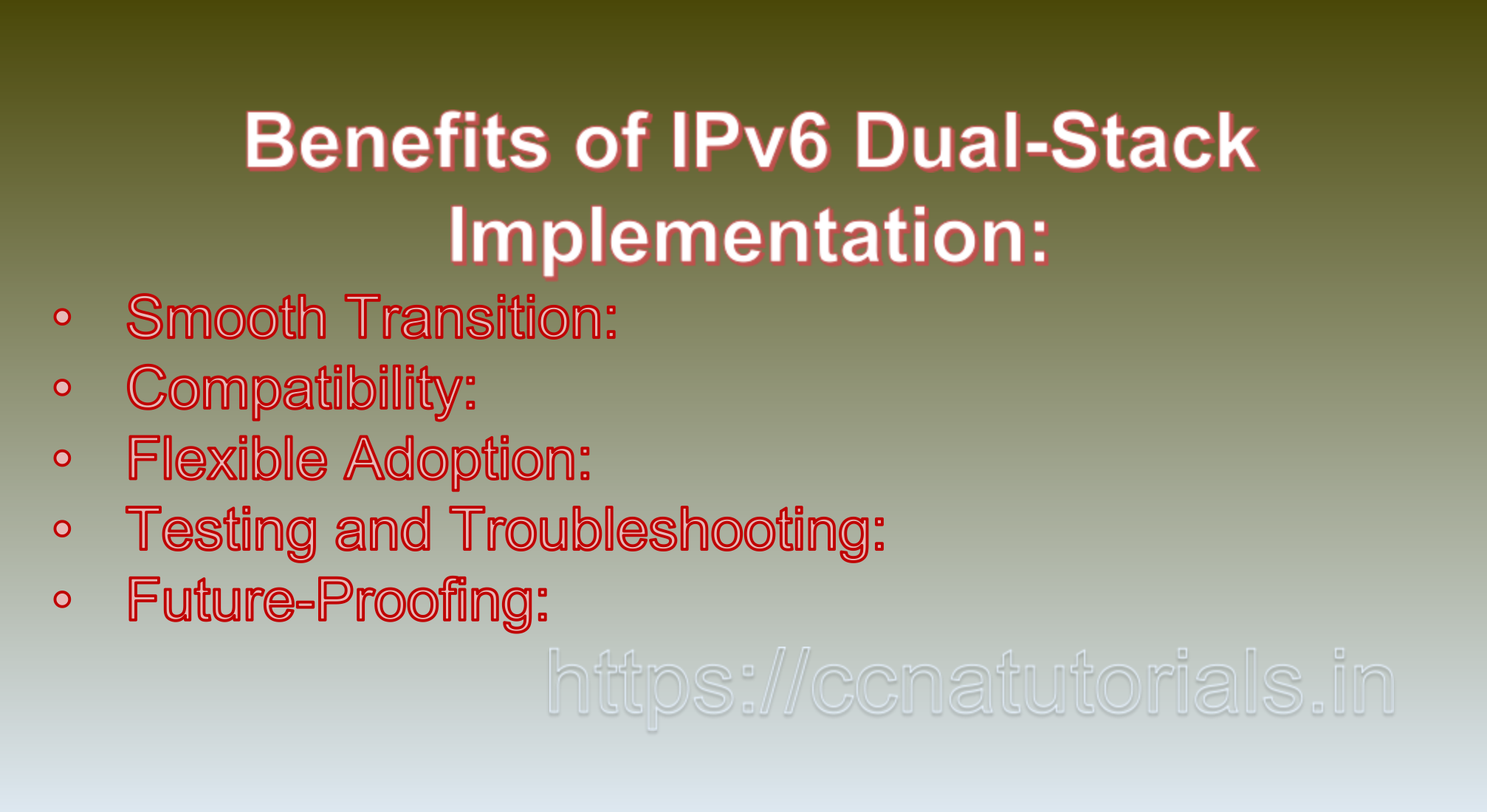Contents of this article
In this article, I describe IPv6 Dual-Stack Implementation: Bridging the Gap between IPv4 and IPv6. IPv6 Dual-Stack Implementation is a widely adopted strategy for transitioning from the current IPv4 protocol to the newer IPv6 protocol. In a dual-stack environment, both IPv4 and IPv6 protocols coexist, allowing devices, networks, and applications to support both addressing schemes. This approach ensures seamless communication and compatibility while facilitating a gradual transition to the enhanced capabilities of IPv6. In this article, we will delve into the concept of IPv6 dual-stack implementation, its benefits, and provide a real-world example to illustrate its significance.
Benefits of IPv6 Dual-Stack Implementation:
1. Smooth Transition:
Dual-stack implementation provides a gradual transition path from IPv4 to IPv6, minimizing disruptions to existing services and users.
2. Compatibility:
Devices operating in a dual-stack environment can communicate with both IPv4 and IPv6 hosts, ensuring compatibility during the transition phase.
3. Flexible Adoption:
Organizations can choose which services or parts of the network to enable for IPv6, based on their specific needs and readiness.
4. Testing and Troubleshooting:
Dual-stack environments allow for testing and troubleshooting IPv6 functionality while still relying on IPv4 as a fallback.
5. Future-Proofing:
By deploying dual-stack, organizations are prepared for the eventual shift to IPv6 and the depletion of available IPv4 addresses.
IPv6 Dual-Stack Implementation Steps:
1. Network Assessment and Planning:
– Organizations evaluate their existing network infrastructure, applications, and devices to determine the readiness for IPv6 deployment.
– A comprehensive plan is developed, outlining the scope of dual-stack implementation, addressing schemes, and potential challenges.
2. Device and Application Support:
– Devices, routers, switches, and applications are updated or configured to support both IPv4 and IPv6 protocols.
– Operating systems, network equipment, and software are checked for compatibility with IPv6.
3. Addressing and DNS Configuration:
– IPv6 addresses are assigned to devices, and DNS records are configured to support both IPv4 and IPv6 resolutions.
– Reverse DNS records (PTR records) are set up to map IPv6 addresses to hostnames.
4. Router Configuration:
– Routers are configured to handle both IPv4 and IPv6 traffic. This includes enabling dual-stack support on router interfaces.
– Routing protocols, such as OSPFv3 and BGP, are configured to exchange routing information for IPv6 networks.
5. Security and Firewall Adjustments:
– Security policies, firewalls, and intrusion detection systems are updated to accommodate IPv6 traffic and ensure consistent security across both protocols.
6. Testing and Verification:
– Devices and applications are tested to verify proper functioning in the dual-stack environment.
– Network connectivity, data transfer, and user experience are evaluated for both IPv4 and IPv6.
7. Deployment and Monitoring:
– Dual-stack implementation is rolled out across the network, ensuring that devices seamlessly communicate using both IPv4 and IPv6.
– Ongoing monitoring and maintenance ensure that the dual-stack environment remains operational and efficient.
Example Scenario of IPv6 Dual-Stack Implementation:
Consider a multinational corporation with offices in various countries. The organization decides to implement IPv6 dual-stack to prepare for the future and improve communication across their networks.
1. Network Assessment and Planning:
– The organization evaluates their network infrastructure and identifies areas suitable for IPv6 adoption. They create a detailed deployment plan, focusing on gradual implementation without disrupting existing services.
2. Device and Application Support:
– IT teams update routers, switches, and servers to support IPv6, ensuring that end-user devices are also IPv6 capable.
3. Addressing and DNS Configuration:
– IPv6 addresses are assigned to devices alongside existing IPv4 addresses. DNS records are configured to accommodate both protocols.
4. Router Configuration:
– Routers are configured to enable dual-stack support on interfaces, allowing them to route both IPv4 and IPv6 traffic.
5. Security and Firewall Adjustments:
– Firewalls are updated to handle IPv6 traffic, and security policies are adapted to cover both protocols.
6. Testing and Verification:
– IT teams conduct extensive testing to ensure that devices and applications function correctly in the dual-stack environment. User experience, data transfer, and connectivity are thoroughly assessed.
7. Deployment and Monitoring:
– The organization deploys IPv6 dual-stack across their network, allowing devices to communicate using both IPv4 and IPv6. Continuous monitoring ensures smooth operations.
In short IPv6 Dual-Stack Implementation:
IPv6 Dual-Stack Implementation is a strategic approach to transition from IPv4 to IPv6 while ensuring compatibility, smooth communication, and future readiness. The example scenario illustrates how an organization can implement dual-stack across its global network, allowing devices to operate seamlessly using both IPv4 and IPv6 protocols. As the demand for Internet-connected devices continues to rise and available IPv4 addresses become scarce, adopting dual-stack becomes crucial for organizations looking to embrace the capabilities of IPv6 while maintaining compatibility with the existing IPv4 infrastructure.

IPv6 Dual-Stack Implementation works like Bridging the Gap Between IPv4 and IPv6. IPv6 dual-stack implementation is a deployment strategy that enables devices, networks, and services to simultaneously support both the IPv4 and IPv6 protocols. This approach allows for a gradual transition from the current IPv4 infrastructure to the newer IPv6 protocol, ensuring compatibility and connectivity for both protocol versions. In this article, we delve into the details of IPv6 dual-stack implementation, its benefits, and provide a real-world example to illustrate its significance.
IPv6 Dual-Stack Implementation:
1. Configuration:
In a dual-stack environment, network devices, routers, servers, and clients are configured to support both IPv4 and IPv6. This involves enabling both protocol stacks on the device.
2. Addressing:
Devices are assigned both an IPv4 address and an IPv6 address. IPv4 addresses are in the familiar dotted-decimal format, while IPv6 addresses are longer and represented in hexadecimal format.
3. Routing:
Routers in a dual-stack implementation are configured to handle both IPv4 and IPv6 traffic. They maintain routing tables for both protocols, ensuring that packets are forwarded to the appropriate destination.
4. DNS:
DNS servers are configured to support both A records (IPv4) and AAAA records (IPv6). This ensures that users can access resources using either protocol.
Benefits of IPv6 Dual-Stack Implementation:
1. Smooth Transition:
Dual-stack implementation allows networks to transition gradually from IPv4 to IPv6 without service disruption. Devices can communicate using the protocol that is best suited for the destination.
2. Compatibility:
Dual-stack ensures compatibility with existing IPv4 infrastructure, applications, and services while facilitating the adoption of IPv6.
3. Interoperability:
Devices in a dual-stack environment can communicate with both IPv4-only and IPv6-only devices, overcoming compatibility challenges.
4. Future-Proofing:
As IPv6 adoption grows, networks that have implemented dual-stack are well-positioned to embrace IPv6 fully without major architectural changes.
Example Scenario of IPv6 Dual-Stack Implementation:
Consider a multinational corporation with offices worldwide. The company recognizes the importance of transitioning to IPv6 to accommodate the growing number of Internet-connected devices and the depletion of IPv4 addresses. To achieve this, the company decides to implement IPv6 dual-stack.
1. Device Configuration:
The company’s IT department configures all network devices, servers, routers, and clients to support both IPv4 and IPv6. Each device is assigned an IPv4 address and an IPv6 address.
2. Addressing:
Devices in the company’s network are assigned IPv4 addresses using the traditional dotted-decimal format (e.g., 192.168.1.1). Additionally, they receive IPv6 addresses in hexadecimal format (e.g., 2001:0db8:85a3:0000:0000:8a2e:0370:7334).
3. Routing:
Routers within the company’s infrastructure are configured to handle both IPv4 and IPv6 routing. They maintain separate routing tables for each protocol, ensuring proper packet forwarding.
4. DNS:
The company’s DNS servers are configured to support both A records (for IPv4) and AAAA records (for IPv6). This enables clients to resolve domain names into both IPv4 and IPv6 addresses.
5. User Experience:
Employees within the company experience a seamless transition. Devices can access resources whether they are using IPv4 or IPv6, enabling uninterrupted communication and services.
6. External Connectivity:
The company’s network interfaces with the external Internet, where a significant portion of resources still operate over IPv4. With dual-stack implementation, the company’s devices can access both IPv4-only and IPv6-only resources.
Conclusion IPv6 Dual-Stack Implementation:
IPv6 dual-stack implementation is a practical and effective strategy for transitioning from IPv4 to IPv6 while maintaining compatibility with existing infrastructure and ensuring seamless communication. The example scenario illustrates how a multinational corporation deploys dual-stack to gradually embrace IPv6 alongside IPv4. As organizations strive to accommodate the growing demands of the digital age, IPv6 dual-stack implementation offers a bridge that facilitates a smoother transition to the next generation of Internet Protocol while preserving connectivity, compatibility, and service continuity. You may drop a comment below or contact us for any query related to this article.






